Ninety percent of instruction is in Hmong for kindergartners in the Hmong immersion program at Susan B. Anthony Elementary. Photo by Andria Lo.
The ABCs of Hmong
By Momo Chang
At Susan B. Anthony Elementary, Mr. Vue’s kindergarteners sit on a brightly colored carpet as they look up at him, repeating sounds of the alphabet.
“Ahhh, aaay, eeeh,” he sings as the children sing along. The sounds are not in English. The school, located in South Sacramento, is home to the only Hmong dual-language immersion program on the West Coast — and the second in the country after a similar program in St. Paul, Minnesota.
Dual, or two-way, language immersion programs are ones where students learn English and another language with the goals of developing a high level of proficiency in both, academic achievement, and appreciation for other cultures. Instructional time includes a minimum of 50 percent in the language other than English. In most cases, schools maintain a balance between fluent English speakers and children who can speak the other language, so that both populations benefit from one another.
“The idea of the Hmong immersion program is so students will become bicultural and biliterate in both English and Hmong,” explains Lee Yang (pronounced “Ya”), the principal and a former director of Sacramento City Unified School District’s Multilingual Literacy Department, who spearheaded the program.
SBA Elementary, Hmong Language Immersion Program from Roldan Lozada on Vimeo.
In the past few years, language immersion programs have sprouted up across the country, particularly in California, where the number nearly doubled from 119 in 2000 to 233 in 2010, according to the California Department of Education. About 200 of these programs are in Spanish; the rest are in Mandarin, Korean, Cantonese, Armenian, German, Italian and Japanese.
In 2011, Hmong was added to the list.
But while languages like Mandarin are witnessing a rapid rise in global prestige, the rewards for students who become fluent in Hmong may be less tangible. Since the first wave of Lao Hmong refugees arrived in 1975, their culture and history has slowly receded, and with it, their language.
Preserving the Past
“They know that they are Hmong,” says Melany Lo, a 1st grade parent in the Hmong program, “but they don’t even know the tradition or culture.” It’s a concern shared by many in the community who fear that in future generations their history will be forgotten.
According to census data, a whopping 45 percent of Hmong Americans are under the age of 17. Parents and teachers expressed concerns that their culture and language were slipping away from this younger generation.
For Vue’s students, that’s where the learning begins.
On one wall in his classroom is a large, colorful tapestry. The embroidered quilt, or story cloth, depicts the history of the Hmong people including their migration from Laos to the United States. Handmade dolls dressed in traditional Hmong clothing sit near the doorway.
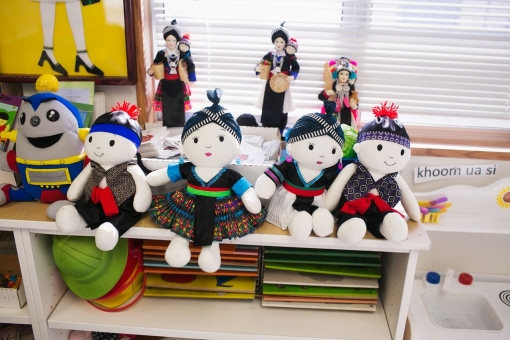
Dolls in traditional Hmong clothing are a part of Sao Vue's kindergarten classroom at Susan B. Anthony Elementary School's Hmong immersion program. Photo by Andria Lo.
The Hmong originated in northern China and later migrated south, where about 9 million Hmong (called “Miao” in Mandarin) still reside. Over the centuries, they continued to move southward, settling in Vietnam, Laos, Thailand and elsewhere. As a people, they have survived genocide and war. In the 1960s and 70s, the Hmong in Laos were recruited to fight in the CIA’s “secret wars” against the Communists during the Vietnam conflict. When that effort was lost, many fled to neighboring Thailand and ended up in refugee camps there.
The first wave of Hmong refugees to the United States arrived in 1975, and the most recent was in 2005. Today there are more than 260,000 Hmong Americans.
All of the students in the immersion program are of Hmong heritage. One in five English learners in the district are Hmong, the second largest group after Spanish speakers. The majority are second or third generation, born in the United States. As with large numbers of U.S.-born Hispanic students, most are also designated English Language Learners, which means they are not proficient in English when entering the program.
But for Vue and his fellow teachers, that isn’t exactly a disadvantage.
Classroom instruction in the program starts with 90 percent Hmong in kindergarten, and is based on the “90/10” model where English is slowly added each year until fourth grade, when the students are taught 50 percent of the time in Hmong and 50 percent in English. That means that in the lower grades, subjects such as math and science are also taught in the Hmong language.
On one autumn day, students in Makaelie Her’s first grade class were writing in their journals in Hmong – a language that did not have its own written alphabet until the 1950s when it was developed by a linguist and missionaries. “If the people don’t read, don’t write, then they don’t know how to provide more literature in their language,” Yang said. “Slowly, their language and their culture disappears. We may still be Hmong, but we may not know anything about Hmong 100 years from now.”
Cece Vang’s two daughters entered Susan B. Anthony’s Hmong program last year. Before that, she says, neither knew much of the language. Today, her eldest, in second grade, speaks in complete sentences and reads books in Hmong. “My brothers and sisters don’t know how to read [Hmong],” says Vang. “My daughter is teaching them how to read.”
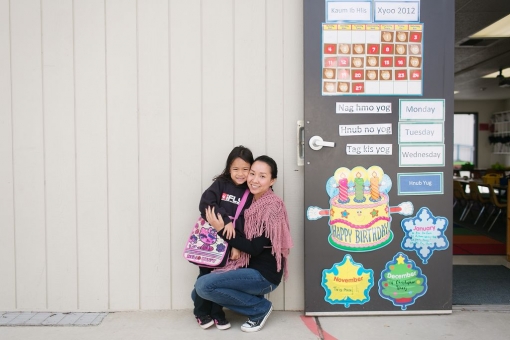
Cece Vang with one of her daughters, who is in the Hmong language immersion program in Sacramento. Photo by Andria Lo.
A Growing Need
Susan B. Anthony’s Hmong program has one class each of kindergarten, first grade and second grade, and operates as a program within the larger elementary school, which sits next to an expansive park. Nearby streets are lined with trees, and on a crisp fall morning, the overall scene is one of an idyllic place to grow up.
The statistics, however, tell a different story.
Located in the “Detroit” neighborhood (named after a street) in South Sacramento, it’s also an area known for gangs, crime, and high rates of poverty. One hundred percent of the elementary school’s 180 children qualify for free or reduced lunch. About 63 percent of them are Asian (most of whom are Hmong), 24 percent are Hispanic/Latino and 8 percent are African American.
Nearly three in four students are English Language Learners.
In spite of these challenges, the school has made impressive gains. Its yearly Academic Performance Index (API) score, which measures California schools on a scale of 200 to 1000, jumped from 461 in 2000 to 742 last year (just below the district’s average of 768) and has met goals for its English Language Learners and low-income students under federal No Child Left Behind guidelines.
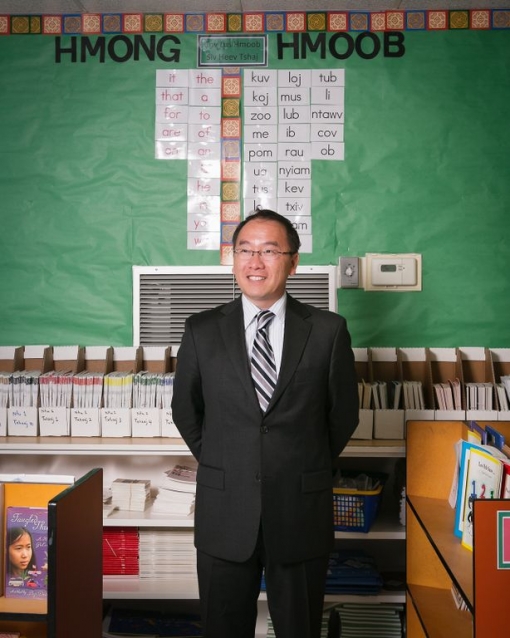
Lee Yang is the principal of Susan B. Anthony Elementary School in Sacramento, CA. Photo by Andria Lo.
Principal Yang, a leader in the tight-knit Hmong community in Sacramento — home to the state’s second-largest Hmong population after Fresno — has spent time as a classroom teacher, principal and administrator. His wife, Bao Moua, is also a principal in the district. In his previous role as district director, Yang was tasked with launching the district’s Mandarin, Cantonese and Hmong immersion programs under District Superintendent Jonathan Raymond.
Three years ago, a charter school with a Hmong cultural focus opened in Sacramento, siphoning off some of the Hmong population from Susan B. Anthony. Shortly thereafter, in the fall of 2011, the Hmong program at Susan B. Anthony opened.
The first Hmong dual language immersion program in an American public school system opened in St. Paul’s Jackson Preparatory Magnet in 2006.
“I think the school districts need to understand that there is a growing need there,” says Lee Pao Xiong, co-founder of two Hmong charter schools in Minnesota and director of the Center for Hmong Studies at Concordia University in St. Paul. “And if [they] can meet the parents’ need in terms of language, culture and history, the parents would prefer the kids to be integrated rather than segregated.”
More than one in three Hmong in the U.S. do not have a high school diploma, and 26 percent of Hmong families live below the poverty level. For those in the dual language immersion programs, more rigorous curricula and hours spent learning in two languages promise a path to reversing these troubling numbers.
Research shows that in the early years, English test scores for students in dual language immersion programs may be lower than their mainstream counterparts. But by late elementary or middle school, most will have caught up to — or surpassed — their peers in English-only classrooms in both English and math, according to studies by Wayne Thomas and Virginia Collier of George Mason University, and Kathryn Lindholm-Leary and her colleagues at San Jose State University, among others.
And while the Hmong program in Sacramento is still new, there are already promising outcomes. A school-based assessment for English and math from spring 2012 showed that none of the students were far below basic level, even as some in the regular English classes were.
Other outcomes may not show up on test scores. Yang noted that many Hmong kids tend to be shy in regular classes, but in the Hmong classes, they raise their hands to speak or to solve a math problem at the whiteboard.
Lost in Translation
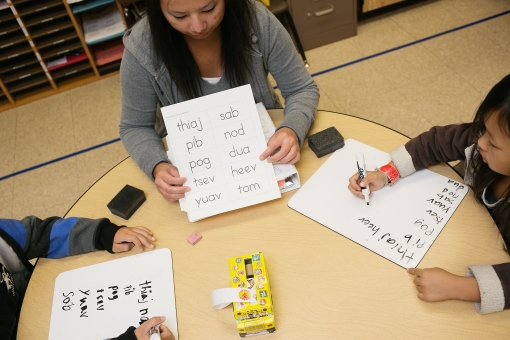
First graders in the Hmong immersion program at Susan B. Anthony Elementary work on their writing and vocabulary. Photo by Andria Lo.
A typical day for Sao Vue, Her and Chia Thao, the teachers in the program, begins before 7 a.m. Most remain long after school has ended, and are often there on the weekends. Their commitment is the product of both practical necessity and personal experience.
“Growing up, because I didn’t have this program, there was a period in my life where I was ashamed to be Hmong,” explains Her, 38, who was born in Laos and spent much of her childhood in Stockton, Calif.
“I was one of the English learners who struggled with English and there wasn’t any program to support me,” she continues. “That’s one of the reasons why I wanted to become a teacher, so that I could actually reach out to other Hmong students and provide them the support that I never got growing up.”
Still, Her admits the program is not without its challenges.
One of those is attracting more students, including those from outside the Hmong community. “We want other ethnic groups to participate,” says Yang, “so that we can become a more rich program.”
That may be a challenge, however, as Hmong is still a largely unknown language.
Still, at the Hmong International Academy, a Minneapolis public school, about 16 percent of students are African American. The school is not an immersion program, but uses the Hmong language to accelerate the learning of another culture, demonstrating Hmong’s capacity to draw in diversity.
The teachers say that among the biggest hurdles is curriculum development. They say there are few options available for materials in Hmong, and while the school has already purchased whatever was available, the rest they are creating from scratch. This includes not only translating materials, but creating a curriculum that fits with Common Core, national standards in English Language Arts and Math that California and the majority of
other states have adopted.
There is also a shortage of bilingual and bicultural teaching staff available,says Kathryn Lindholm-Leary, who helped spearhead the first dual language programs in the 1980s.
“In the U.S. we don’t do a lot of foreign language development,” she says, “and so you’re talking about people who grew up speaking that language in their home but they were basically educated in English so their literacy and vocabulary skills might be somewhat limited.”
Vue’s story is different. Having come to the United States at 17, the 40-year-old spent most of his childhood growing up in a Thai refugee camp, where he says he developed an early appreciation for teachers. Vue began teaching at Susan B. Anthony in 1997, transitioning to the Hmong program when it opened in 2011.
Both he and Yang have staked a great deal on the program. Their kids are now enrolled and will be among the first cohort of Hmong-fluent graduates.
“We have a mountain of work to be done, a lot of things that need to be planned,” Vue said. “When I get older, I want [my students] to be my heroes so they can support themselves and become productive members of society.”
He adds: “If they don’t know who they are, they are kind of lost.”
Momo Chang is a freelance journalist based in Oakland, Calif. where she writes, edits and produces stories about social issues. She is the features editor at Hyphen, a magazine and website devoted to coverage of Asian American arts, culture and politics. She previously taught high school English, and her son is in a Mandarin immersion school.
Photos by Andria Lo. Video and additional reporting by R.J. Lozada.
This story was produced as part of New America Media's 2012 education reporting fellowship for ethnic media journalists in California, with support from the California Education Policy Fund (CEPF) and the David and Lucile Packard Foundation.









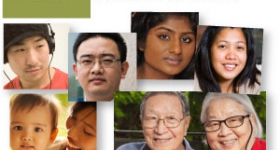
Comments